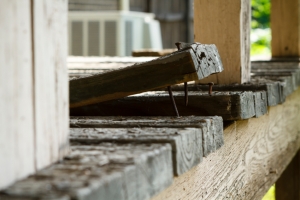May is National Deck Safety Month and for good reason. As the weather warms up and outdoor entertaining begins again, lots of us will be migrating to our decks for grilling, parties and just general relaxation. Making sure you have a safe place for family and friends to gather is an important homeowner responsibility.
According to the North American Deck and Railing Association (NADRA), an estimated 40 million residential and 10 million commercial decks in the United States are between 20 and 30 years old. Even if your deck isn’t that old, it’s important to check it on a yearly basis. Once a deck starts to deteriorate, it not only becomes unattractive – it also can become unsafe, causing everything from nasty slivers to broken bones and worse, the collapse of an entire deck.
When you think about what the average deck has to endure, it’s little wonder there is a booming business in deck replacement these days. Decks take a beating from a number of sources, particularly with the weather extremes we have in eastern Iowa. From the unrelenting glare of the sun to being buried under piles of snow several months of the year, environmental damage to a deck is inevitable over time. In addition to the elements, there is the normal wear and tear caused by foot traffic, moving furniture, barbeques and grills.
We recommend taking some time every year to inspect your deck. Here are important areas you should look at when inspecting your deck:
Deck ledger board problems – The ledger board is the horizontal wood framing that attaches the deck to your home. If there is space between where your deck connects to the house at the ledger board – this is a major danger sign. Issues with the deck ledger board are the most worrisome because they can cause total deck collapse.
Sagging support beams – If you see obviously sagging support beams under the deck, this needs immediate attention as well. Call a professional right away for a thorough inspection and safety check.
Rotting wood – Signs that your deck may have rotted or decayed include changes in color or texture. It may feel “spongy” when you apply pressure. Loose nails and missing screws can also be a sign of rot. If you see rotting wood or cracked surfaces, you may be able to replace just those areas. However, if the rot is widespread, you may be better off replacing the entire deck as the rot may actually be threatening the structural integrity of the deck.
Wobbly support posts – One simple test of the sturdiness of the deck is to check how solid the support posts are. If you can wiggle the posts significantly, it may be a sign the entire structure is at risk.
These are just a few of the most obvious signs that you may have a problem with your current deck. In honor of National Deck Safety Month, NADRA offers a free consumer checklist homeowners can download with more detailed information on how to inspect your deck.
If you are past the point of wondering if you should replace your deck, or if you are just ready to add a new deck, download our FREE Deck Planning Checklist to get started on your plan.

